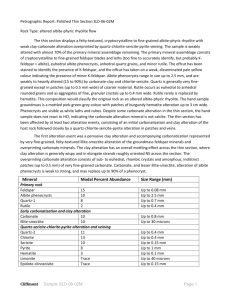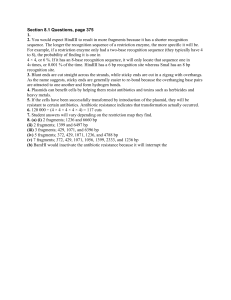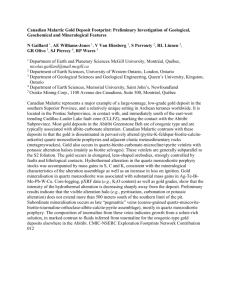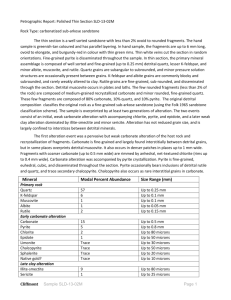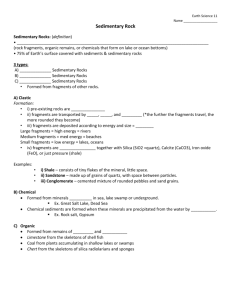SLD-08-01M psm
advertisement
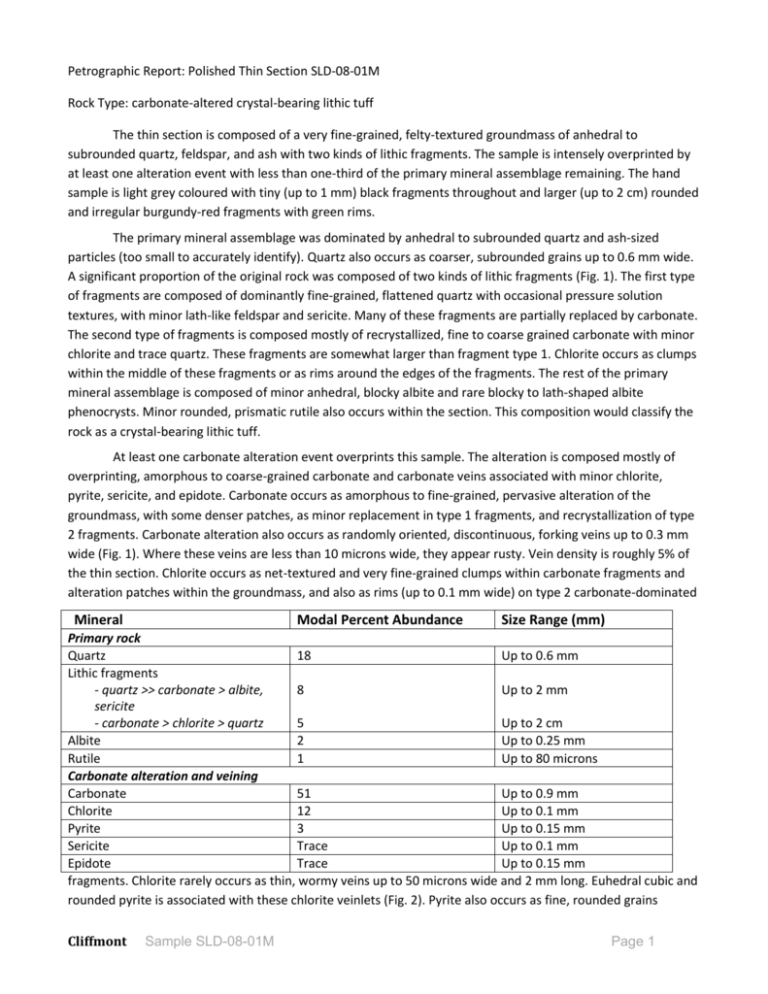
Petrographic Report: Polished Thin Section SLD-08-01M Rock Type: carbonate-altered crystal-bearing lithic tuff The thin section is composed of a very fine-grained, felty-textured groundmass of anhedral to subrounded quartz, feldspar, and ash with two kinds of lithic fragments. The sample is intensely overprinted by at least one alteration event with less than one-third of the primary mineral assemblage remaining. The hand sample is light grey coloured with tiny (up to 1 mm) black fragments throughout and larger (up to 2 cm) rounded and irregular burgundy-red fragments with green rims. The primary mineral assemblage was dominated by anhedral to subrounded quartz and ash-sized particles (too small to accurately identify). Quartz also occurs as coarser, subrounded grains up to 0.6 mm wide. A significant proportion of the original rock was composed of two kinds of lithic fragments (Fig. 1). The first type of fragments are composed of dominantly fine-grained, flattened quartz with occasional pressure solution textures, with minor lath-like feldspar and sericite. Many of these fragments are partially replaced by carbonate. The second type of fragments is composed mostly of recrystallized, fine to coarse grained carbonate with minor chlorite and trace quartz. These fragments are somewhat larger than fragment type 1. Chlorite occurs as clumps within the middle of these fragments or as rims around the edges of the fragments. The rest of the primary mineral assemblage is composed of minor anhedral, blocky albite and rare blocky to lath-shaped albite phenocrysts. Minor rounded, prismatic rutile also occurs within the section. This composition would classify the rock as a crystal-bearing lithic tuff. At least one carbonate alteration event overprints this sample. The alteration is composed mostly of overprinting, amorphous to coarse-grained carbonate and carbonate veins associated with minor chlorite, pyrite, sericite, and epidote. Carbonate occurs as amorphous to fine-grained, pervasive alteration of the groundmass, with some denser patches, as minor replacement in type 1 fragments, and recrystallization of type 2 fragments. Carbonate alteration also occurs as randomly oriented, discontinuous, forking veins up to 0.3 mm wide (Fig. 1). Where these veins are less than 10 microns wide, they appear rusty. Vein density is roughly 5% of the thin section. Chlorite occurs as net-textured and very fine-grained clumps within carbonate fragments and alteration patches within the groundmass, and also as rims (up to 0.1 mm wide) on type 2 carbonate-dominated Mineral Modal Percent Abundance Size Range (mm) Primary rock Quartz 18 Up to 0.6 mm Lithic fragments - quartz >> carbonate > albite, 8 Up to 2 mm sericite - carbonate > chlorite > quartz 5 Up to 2 cm Albite 2 Up to 0.25 mm Rutile 1 Up to 80 microns Carbonate alteration and veining Carbonate 51 Up to 0.9 mm Chlorite 12 Up to 0.1 mm Pyrite 3 Up to 0.15 mm Sericite Trace Up to 0.1 mm Epidote Trace Up to 0.15 mm fragments. Chlorite rarely occurs as thin, wormy veins up to 50 microns wide and 2 mm long. Euhedral cubic and rounded pyrite is associated with these chlorite veinlets (Fig. 2). Pyrite also occurs as fine, rounded grains Cliffmont Sample SLD-08-01M Page 1 disseminated throughout the groundmass and overprinting only the carbonate-altered type 1 quartz-dominated fragments. Sericite occurs in trace amounts in the sample and occurs as very fine-grained laths associated with carbonate. Epidote also is a trace mineral and occurs as rounded grains associated with carbonate alteration. This alteration assemblage is most similar to the propylitic alteration, except that it lacks secondary albite and abundant epidote. frag1 frag2 py vein Figure 1: Photomicrograph of the two types of lithic fragments in this sample: fragment type 1 (frag1) are those fragments dominated by flattened quartz grains with minor feldspar and sericite, and minor carbonate alteration. Fragment type 2 (frag2) are those composed of recrystallized carbonate with chlorite rims and minor quartz. This image also shows a weakly developed carbonate vein (vein). Photo taken in cross polarized transmitted light. Cliffmont Sample SLD-08-01M chl rt Figure 2: Photomicrograph of a thin, wormy chlorite (chl) veinlet hosting minor pyrite (py). Minor primary rutile (rt) is also present. Photo taken in plane polarized reflected light. Page 2

